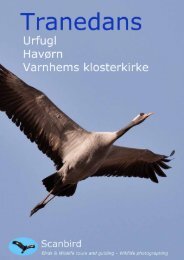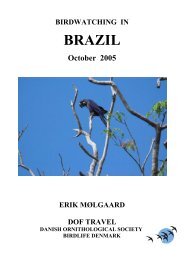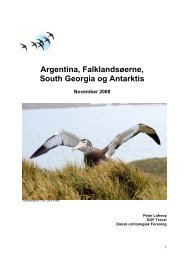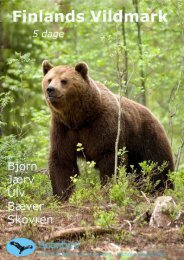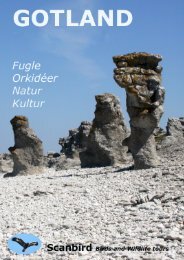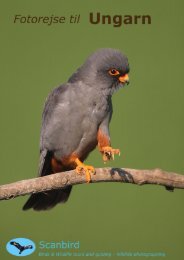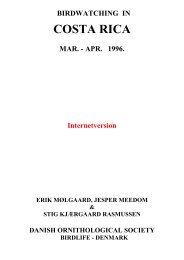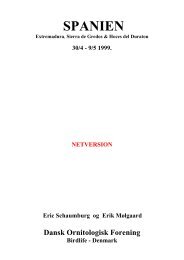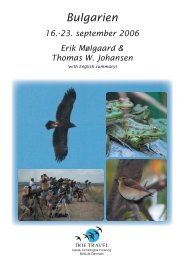Birding Southern Sweden (large PDF file (5 MB) - Tåkerns Fältstation
Birding Southern Sweden (large PDF file (5 MB) - Tåkerns Fältstation
Birding Southern Sweden (large PDF file (5 MB) - Tåkerns Fältstation
You also want an ePaper? Increase the reach of your titles
YUMPU automatically turns print PDFs into web optimized ePapers that Google loves.
Falsterbo<br />
P-G BENTZ<br />
It has been estimated that about 500 million birds leave Scandinavia<br />
every autumn. The migration goes on day and night at<br />
different altitudes. Some species spend the winter in western<br />
Europe or in the Mediterranean area. Others cross the vast Sahara<br />
desert and winter in the tropics.<br />
Migrating birds do not fly over unknown or perilous areas<br />
unless they have to. For many birds the Baltic Sea is the first<br />
difficult barrier to cross on the southwestward migration route.<br />
Therefore, the birds rather follow the south and west coasts of<br />
<strong>Sweden</strong> until they finally reach Falsterbo. On good days you<br />
can see hundreds of thousands of birds migrating at Nabben,<br />
the southwesternmost point of the Falsterbo Headland. Most<br />
spectacular is the migration of raptors.<br />
Falsterbo Headland is mainly built up of sand formed around<br />
some morainic ridges. The area constantly changes its shape and<br />
size as the sand is moved around by sea currents and wind. For<br />
centuries it was a treeless heathland with sand dunes, grazed<br />
meadows and fields. Nowadays this open landscape is mixed<br />
with woodlands and villa areas with many gardens.<br />
The shallow shores of the Falsterbo Headland and Foteviken<br />
provide conditions for a rich production of the basic food for all<br />
kinds of shore-birds. Large parts of the coasts are included on<br />
the list of internationally important wetland areas (Ramsar areas)<br />
and Nature-2000 areas.<br />
The autumn migration starts already in July, when waders,<br />
gulls and terns pass. From mid-August and about three weeks<br />
onwards passerines like Tree Pipits, Yellow Wagtails and Swallows<br />
are numerous and at about the same time the first migrating<br />
raptors are seen, usually Marsh Harriers and Ospreys.<br />
Towards the end of August the peak of the migration of Honey<br />
Buzzards occurs. Many other raptor species are also seen, for<br />
example Black Kite, Montagu´s Harrier, Lesser Spotted Eagle,<br />
Short-toed Eagle and Red-footed Falcon. Still, lots of waders<br />
can be seen along the shores and in trees and shubberies many<br />
nocturnal migrants stop over. Late August is also the right time<br />
to find Wryneck and Red-backed Shrike.<br />
During September the long-distance migrants are gradually<br />
replaced by those which spend the winter in the Mediterranean<br />
area or in south-west Europe. Honey Buzzards are replaced by<br />
Common Buzzards and Marsh Harriers by Hen Harriers. Red<br />
Kites are usually reaching their peak numbers during the end of<br />
September. Spotted Eagle and Steppe Eagle can be seen and<br />
sometimes Imperial Eagle.<br />
”At regular intervals an occasional Osprey and Marsh Harrier<br />
pass by. Suddenly a <strong>large</strong>r and completely dark bird of prey<br />
appears alongside the Buzzards: a Lesser Spotted Eagle! It is<br />
the same bird as was seen a few days ago, at the time alongside<br />
another two Lesser Spotted Eagles and one Short-toed Eagle!<br />
At noon it happens at last. In the distance we discover a<br />
flock of buzzards of about a hundred birds close together in<br />
a typical Honey Buzzard manner. Soon they are above us in<br />
<strong>large</strong> silent flocks. More and more appear and in the midst<br />
of them three more Lesser Spotted Eagles are discovered,<br />
neither of them identical to the one seen earlier.<br />
The whole afternoon offers an endless stream of Honey<br />
Buzzards (in the end some 3000 during the day) and in<br />
addition hundreds of Sparrowhawks as well, more Marsh<br />
Harriers and Ospreys and even the fifth Lesser Spotted Eagle<br />
of the day. The last Ospreys appear just as the setting sun is<br />
sending its low rays over the purple flowering heather.”<br />
From the bird observatory’s diary 26 August 1989.<br />
(Klaus Malling Olsen)<br />
6



